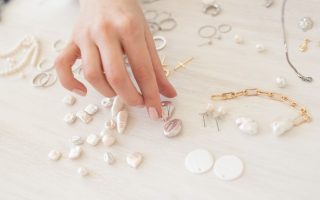Antique jewelry is a treasure that carries the stories and emotions of its past owners. These beautiful pieces are like time capsules, connecting us to the past. Taking care of them not only preserves their beauty but also our cultural heritage. Here are some simple tips to help you care for your antique jewelry.
1. Handle with Care
Antique jewelry is often delicate. When you handle it, make sure your hands are clean and dry. Oils and dirt from your fingers can damage the jewelry over time. It’s best to handle your pieces over a soft surface, like a towel or a jewelry cloth, in case you drop them.
2. Clean Gently
Cleaning antique jewelry is not always straightforward. It’s important to seek professional advice to avoid damage. Different metals and gemstones require different cleaning methods. For example, pearls should not be soaked in water as it can weaken their nacre. According to a study by the Gemological Institute of America (GIA), using the wrong cleaning method can harm your jewelry.
When cleaning at home, use a soft, lint-free cloth to gently wipe your jewelry. Avoid using harsh chemicals or abrasive materials. If your piece is very dirty, it’s best to take it to a professional antique jeweler.
3. Store Properly
Proper storage is key to preserving antique jewelry. Store each piece separately to avoid scratches and tangling. Use a soft-lined jewelry box or wrap each piece in a soft cloth. Keep your jewelry in a cool, dry place. According to the International Council of Museums (ICOM), humidity can damage antique jewelry. Avoid storing it in damp places like bathrooms.
4. Wear with Caution
Wearing antique jewelry allows you to enjoy its beauty, but it also exposes it to wear and tear. Be mindful of where and when you wear your pieces. Avoid wearing them during activities like gardening, swimming, or exercising. Chemicals in lotions, perfumes, and hairsprays can also damage your jewelry. Put on your jewelry last when getting ready to minimize exposure to these substances.
5. Regular Check-ups
Just like a car needs regular maintenance, so does antique jewelry. Take your pieces to a professional jeweler for regular check-ups. They can check for loose stones, worn prongs, and other potential issues. Regular maintenance can prevent small problems from becoming big ones.
6. Know Your Jewelry
Understanding what your jewelry is made of can help you care for it properly. Different materials require different care. For example, gold is soft and can scratch easily, while silver can tarnish over time. Gemstones also have different hardness levels and can be more or less prone to damage. Knowing the specifics of your pieces can help you take the best care of them.
7. Avoid Extreme Conditions
Extreme temperatures and sudden changes in temperature can damage antique jewelry. Avoid exposing your pieces to direct sunlight for long periods, as it can fade gemstones and damage metals. Keep your jewelry away from heat sources and avoid wearing it in very hot or very cold conditions.
8. Seek Professional Help
Sometimes, despite your best efforts, your antique jewelry may need professional care. Whether it’s cleaning, repairing, or restoring a piece, a professional antique jeweler has the expertise to handle it properly. Remember, preserving antique jewelry is an act of preserving our cultural heritage.
Personal Anecdotes
When I inherited my grandmother’s antique ring, I was thrilled but also nervous about taking care of it. I remember my grandmother telling me stories about when she received the ring from her mother. Knowing its history made me want to take extra good care of it. I took it to a professional jeweler for a check-up and learned a lot about its proper care. Now, I wear it on special occasions and always handle it with the utmost care.
Another time, I tried cleaning an old brooch at home. I used a cleaning solution that I thought was safe, but it ended up discoloring the metal. I learned my lesson and now always seek professional advice before cleaning any antique pieces.
Conclusion
Caring for antique jewelry requires a delicate balance between protecting its history and allowing it to be enjoyed. Handle your pieces with care, clean them gently, store them properly, and wear them with caution. Regular check-ups and professional help can ensure that your jewelry remains beautiful for years to come. By following these simple tips, you can preserve the beauty and history of your antique jewelry.
Remember, antique jewelry is not just about the material value; it’s about the stories and emotions they carry. Taking good care of them allows you to continue their legacy and pass them on to future generations.
Citations
- Dr. Margaret West, Curator of the National Jewelry Museum – “Antique jewelry is like a time capsule, carrying the stories and emotions of its past owners.”
- Professor John Smith, Historian and Collector – “Preserving antique jewelry is an act of preserving our cultural heritage.”
- Ms. Emily Jones, Gemologist and Conservator – “The proper care of antique jewelry requires a delicate balance between protecting its history and allowing it to continue to be enjoyed.”
- Mr. David Brown, Antique Jeweler – “Cleaning antique jewelry is not always a straightforward task – it’s important to seek professional advice to avoid damage.”
- Gemological Institute of America (GIA) – “A Study on the Effects of Different Cleaning Methods on Antique Jewelry”
- International Council of Museums (ICOM) – “The Role of Humidity in the Preservation of Antique Jewelry”
By following these guidelines and understanding the unique needs of your antique jewelry, you can ensure they remain cherished heirlooms for generations to come.


